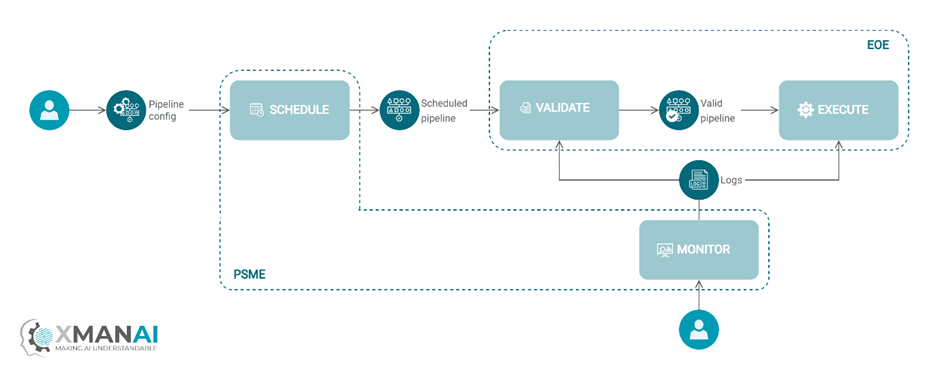XMANAI Centralized Models Execution and Visualization Environment
XAI models are essential in enabling businesses to make data-driven decisions more efficiently and effectively. For this reason, the XMANAI platform is designed to natively support the execution of XAI models, which are at the core of XMANAI pipelines.
The Execution & Orchestration Engine (EOE) is the key platform component that enables execution of user-defined explainable pipelines, providing a dedicated environment optimized to run AI and ML tasks. The ability to run XAI pipelines in either in the XMANAI fully managed cloud environment or in a dedicated on-premise setting is another valuable feature that provides organizations with greater control and flexibility over their processes.
Throughout the execution process, the user can monitor the status of his pipelines using the Pipeline Serving & Monitoring Engine (PSME). This component allows the user to gain valuable insights about the status of each block of the pipeline in real-time, providing detailed logs for both the low-level block execution and the high-level model output. This level of transparency provides users with a clear understanding of what is happening at every step of their AI pipeline and enables them to quickly identify and resolve any issues that arise during the execution process.
Let’s see the key steps to follow in order to set up, execute and supervise an XAI pipeline.

- Our journey starts with a XAI pipeline designed by the user comprising all the required steps to accomplish the desired task and the desired model(s) to be used.
- A custom schedule can be attached from the Pipeline Serving & Monitoring Engine by the user. The pipeline can be scheduled to run once at a specific date and time, or in a repeating pattern every day, week, month and so on.
- With the pipeline ready and scheduled, the user can now submit it for execution to the Execution & Orchestration Engine.
- The EOE performs a validation process to ensure the pipeline complies with the requirements specified by the user and produces a report of this activity.
- Upon successful validation, the XAI pipeline is marked as ready. A series of optimizations are performed, and the execution will be triggered according to the given schedule. The EOE will take care of handling the ML workload in a trusted and isolated environment, leveraging parallel computing whenever possible.
- The user can monitor the validation and execution processes through the PSME real-time dashboard. This allows the user to identify and resolve any issues that arise during the build and execution processes, ensuring a smooth and efficient pipeline execution.
Overall, designing and executing an XAI pipeline is a comprehensive process that requires careful planning and execution. By following these key steps, users can ensure that their pipelines are properly scheduled, validated, and executed, providing valuable insights into their operations.

